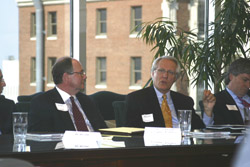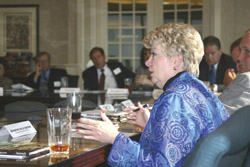
Kent Sullivan of Stinson Morrison Hecker speaks of the virtues of arbitration and avoiding litigation. His associate John Granda is shown on the left and Craig O’Dear of Bryan Cave on the right.
Diversity and its Consequences
What had been a relatively restrained discussion in the first half grew more animated in the second when Cathy Dean raised an issue, first privately and, when prodded, publicly, of shared interest.
Dean spoke of a presentation at a KCMBA diversity program in which the presenter showed a picture from the Legal Industry Outlook of two years ago and asked rhetorically whether that photo represented the Kansas City legal community. “I was embarrassed,” said Dean. “I was embarrassed today.”
The source of her embarrassment was the absence of any identifiable minorities in that year’s photo or in this year’s assembly. Although there have been minorities present in some years, there have been more years in which none were present. The Legal Industry Outlook is not unique in this regard. The series tends to reflect the reality of power in Kansas City. Although some of the Industry Outlooks are well represented by women and minorities—small business, government and higher education come to mind—some obviously are not.
Joe Sweeney observed that Ingram’s invites the managing partners of the more influential corporate firms and often times allows them to bring an associate. “It may not be scientific or politically correct,” Sweeney said, “but we try our best.” Generally speaking, Ingram’s selects a given category and then tries to include as diverse a cast as fits that category, usually working from the top 25 list. Everyone invited to a given assembly knows that he or she belongs there for reasons other than race or gender. No one is patronized.
There are complications. In one recent assembly, for instance, the magazine invited an African-American woman, who by any definition, deserved a seat at the table. Due to a last-minute conflict, however, she sent her number-two person, who was a white male. This color-blind gesture on her part left the unknowing but racially sensitive reader an unfair impression of Ingram’s efforts. This is not an issue easily resolved.
Bill Carr acknowledged that the Industry Outlooks mirror the business establishment of the legal industry. “It will change,” he observed, “but we have to make it happen.”
“Look around the room, and you see we have a long way to go,” said John Murphy, “but we’ve come a long way as well.”

Jennifer Gille Bacon of Shughart Thomson & Kilroy explores the challenges associated with recruiting and retaining minorities in the legal profession.
Joe Hiersteiner was not one to let Ingram’s off the hook. He argued that Ingram’s did not have to create a special category to insure minority representation at an assembly of this nature. The magazine needed “to do a better job” in reaching out.
Jack Kilroy suggested that there are topics that would produce a different group like, for instance, an emphasis on bar leadership. “It could be an impressive sort of thing,” he noted.
As the participants realized, however, the real issue was not Ingram’s Industry Outlook; the real issue was the respective firms’ ability to recruit and retain minority lawyers. “It’s a huge issue for us,” said Craig O’Dear, who spoke of the “tremendous pressure” law firms are under from their own clients to hire minorities.
Compounding the difficulty is that Kansas City does not have “the active environment for young professionals” of, say, Washington and Atlanta—cities chosen by two of Bryan Cave’s recent interns. “We are competing with cities that have established communities of black professionals,” agreed Carl Helmstetter. “It would not hurt for our city to look a little more snazzy,” added Dave Fenley.
Kim Jones did not deny that there was a supply and demand component, but suggested that there were a lot of untapped resources, like the Asian bar and the Hispanic bar. The Urban League, she noted, has a hiring and recruiting program for which no large law firms have signed up.
One effort to recruit more minorities is the KCMBA job fair scheduled for September. Jennifer Gille Bacon noted that their initial goal was to have 75 to 100 candidates, but the fair has proved much more attractive. Tom Stewart, who is helping arrange it, has had to cut off the number of recruits at 200 for logistical reasons.
The question was raised as to whether law firms maintain the same standards for minorities that they do for non-minority candidates. “Everybody lowers them,” said one participant. “We will hire the best minority candidates,” said another more diplomatically.
“It is a broader question than that,” clarified Russ Welsh.
“We have to rethink who is a qualified applicant,” added Kim Jones. “We’re not lowering the standard. We’re redefining what is qualified.”
As Dave Fenley noted, clients often look for diversity in litigation teams for the reason that it helps them reach diverse jury pools.
“Clients want attorneys who mirror the population,” agreed Jennifer Gille Bacon. “One of the reasons is enlightened self interest.” According to Irv Belzer, some of the large companies want the law firms to track the percentage of hours logged by minority lawyers within a firm.
“To be provocative,” said Anita Robb. “We must recognize that things will not get better.” As a reason she cited not the good will of the lawyers assembled, but what she sees as cutbacks in financial aid, which potentially will limit the supply pool even more.
Although acknowledging the problem of supply, Peter Brown pointed to institutions like Helzberg’s Charter School, which will have a thousand kids, a 98 percent minority enrollment, and a determination to find a way to fund every one who wants to go to college.
Jennifer Gille Bacon spoke to a problem deeper than the Industry Outlook photo, the recruitment efforts by the law firms or even the financial aid available to would-be students, and that is the fact that the education problem begins all the way back in Head Start, if not before. When the discussion reaches that point, she said, “everyone looks at each other and freezes.”